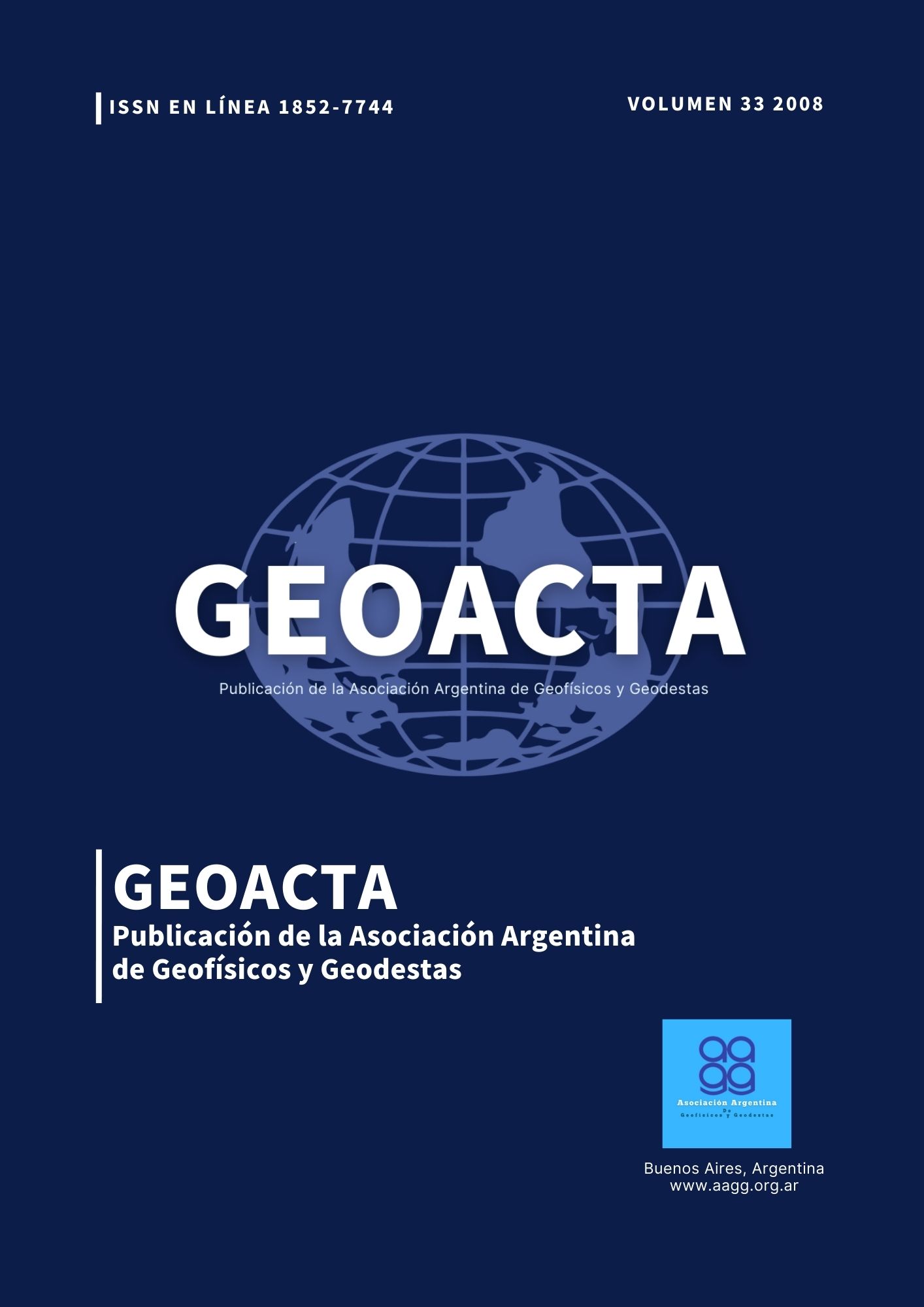Fluctuaciones interanuales a multidecádicas de la temperatura de verano en el centro-oeste de Argentina y procesos atmosféricos/oceánicos/astronómicos globales
Palabras clave:
Cambio Climático, Ciclo Solar, Temperatura, Rayos CósmicosResumen
La temperatura estival (octubre-marzo) en la región Centro-Oeste de Argentina (COA, 28°-36°S y 65°-70°O) tiene un comportamiento espacial coherente y temporal en fase, en escalas interanuales a interdecádicas (Agosta y otros 2004). Se encuentra que la temperatura del aire presenta cuasi-oscilaciones significativas en las bandas de 11 años y 18 años aproximadamente. La primera se vincula al forzante solar, la segunda, a los efectos de la transición climática de 1976/77 (IPCC, 2001). Esta transición afectó transitoriamente la variabilidad de baja frecuencia de la temperatura como fenómeno de interferencia sobre el cuasi-ciclo solar de 11 años dominante.
Descargas
Referencias
Agosta, E.A., Compagnucci R.H. y Vargas, W.M. 1999: Cambios en el régimen interanual de la precipitación estival en la región Centro-Oeste Argentina. Meteorol. 241/2, 63-84.
Agosta, E.A. (2004): Variabilidad del clima terrestre y rayos cósmicos galácticos durante el ciclo solar de 11 años: revisión teórica, Meteorol., 29 (1 y 2), 47-62.
Agosta, E.A., Castañeda M.E. y Compagnucci, R.H. 2004: Estudio Preliminar de la Variabilidad Climática de la Temperatura estival en la región Centro-Oeste Argentina, CD de la XXII Reunión de la Asociación Argentina de Geofísicos y Geodesias, Buenos Aires, 10p.
Agosta, E.A., y Compagnucci R.H. (2006)a: Change in Teleconnection between Central-West Argentina Summer Precipitation and the Atmospheric Circulation in the 1970s. 8th ICSHMO, AMS, Foz do Iguaçu, Brasil, Ses. 12: Understanding long-term climate variations in the SH, 1453-1464.56
Agosta, E.A., y Compagnucci R.H. (2006)b: Atmospheric Conditions During wet and dry summer extremes in Central-West Argentina. 8th ICSHMO, AMS, Foz do Iguaçu, Brasil, Ses. 12: Understanding long-term climate variations in the SH, 1439-1452.
Bard, E., G. Raisbeck, F. Yiou, and J. Jouzel, 2000, Solar irradiance during the last 1200 years based on cosmogenic nuclides. TELLUS, B 52 (3): 985-992.
Boer, G. J., K. Hamilton, W. Zhu 2005: Climate sensitivity and climate change under strong forcing. Clim. Dyn . 24 (7), 685 – 700.
Camilloni I., Barros V., Escobar G. y Di Luca A. 2005: Tendencias en la posición del anticiclón del atlántico sur y su representación por modelos climáticos globales: impactos sobre el estuario del Río de la Plata y océano adyacente. IX Congreso Argentino de Meteorología. Buenos Aires, 3-7 de octubre, 2005.
Compagnucci, R.H. Agosta, E.A., Vargas M.W., 2002: Climatic change and quasi-oscillations in central-west Argetnina summer precipitation: main features and coherent behaviour with southern African region. Cli. Dyn. 18, 421-435.
Ebbesmeyer C.C., Cayan D.R., McLain D.R., Nichols F.H., Peterson D.H. and Redmond T. 1991: 1976 Step in the Pacific Climate: Forty enviromental changes between 1968-1975 and 1977-1984. Proceeding of the 7th Annual Pacific Climate PACLIM, Workshop, April 1990, Eds. Betancourt, J.L. y V.L. Tharp, Californian Dep. of Water Resources, Interagency Ecological Studies Program, Tech. Rep. 26, 115-126.
Eddy, J.A. (1976): The Maunder minimum, Science, 192, 1189-1202.
Federov, A.V. and Philander, S.G. 2000: Is El Niño Changing? Science, 288, 1997-2001.
Godfrey, J.S. y S.T. Rintoul (1998). The role of the Oceans in the Southern Hemisphere Climate. En Meteorolgy
of the Southern Hemisphere. Ed. D.J. Karoly y D.G. Vincent. Am. Met. Soc., 410 pág.
Gu, D.F., and S.G.H. Philander, 1997: Interdecadal climate fluctuations that depend on exchanges between the tropics and extratropics. Science, 275:805-807.
Hoel, Paul G. 1964: Introduction to Mathematical Statistics, John Wiley & Sons, Inc. New Yor-London, 428 pág.
Huang, H.-P., R. Seager, and Y. Kushnir, 2005: The 1976/77 transition in precipitation over the Americas and the influence of tropical sea surface temperature. Clim. Dyn., 24 (7), 721 – 740.
IPCC, 2001: Climate Change 2001: The Scientific Basis, Integovernmental Panel on Climate Change Watson, R.T. and the Core Writing Team, Cam Univ Press.
Jones P.D. 1994. Hemispheric Surface Air Temperature Variations: A Reanalysis and an Update to 1993, Journal of Climate, Vol. 7, No. 11 (repoduced by the GOSTA Plus data set).
Labitzke, K. y van Loon, H. (1992):, J. Clim, 5, 240.
Seager R., Harnik N., Robinson W.A., Kushnir Y., Ting M., Huang H.P., Velez J. 2005: Mechanisms of ENSOforcing of hemispherically symmetric precipitation variability. Q. J. R. Meteorol. Soc. 131(608): 1501-1527.
Seluchi, M., Saulo, C.A., Nicolini, M. y P. Satyamurti 2003: The Northwestern Argentinean Low: a study of two typical events. Mon. Wea. Rev., 131, 2361-2378.
Shaviv, N.J. (2005): On climate response to changes in the cosmic ray flux and radiative budget. J. Of Geo. Res., 110, A08105, doi: https://doi.org/10.1029/2004JA010866
Svensmark, H. 2000, Cosmic rays and Earth´s climate. Spac. Scien. Rev., 93: 155-166.
Tinsley, B.A. Rohrbaugh, R.P. y Hei, M. 2001. Electroscavenging in clouds with broad droplet size distributions and weak electrification, Atmosph. Res. 59-60: 115-135.
Torrence, C. and G. P. Compo (1998): A Practical Guide to Wavelet Analysis. Bull. Amer. Meteor. Soc., 79, 61-78.
Wainer I. y Venegas S.A. 2002: South Altantic Multidecadal VAriability in the Climate System Model, Jou. Of Clim. 15, 1408-1420.
Descargas
Publicado
Número
Sección
Licencia
Derechos de autor 2008 Eduardo Andres Agosta, Paula Beatriz Martin

Esta obra está bajo una licencia internacional Creative Commons Atribución-NoComercial-CompartirIgual 4.0.
Acorde a estos términos, el material se puede compartir (copiar y redistribuir en cualquier medio o formato) y adaptar (remezclar, transformar y crear a partir del material otra obra), siempre que a) se cite la autoría y la fuente original de su publicación (revista y URL de la obra), b) no se use para fines comerciales y c) se mantengan los mismos términos de la licencia.
La licencia CC BY-NC-SA comenzó a utilizarse a partir del Vol. 43 núm. 2 (2022).
Previo a esa fecha, los materiales se publicaron bajo una licencia CC BY.























